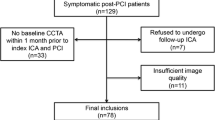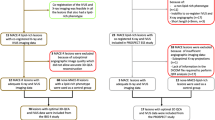Abstract
To date, there are no prospective studies on the relationship between plaque characteristics identified by 40 MHz IVUS and future adverse events. This prospective study evaluated the relationship between plaque morphology in nonculprit nonsignificant lesions, determined by 40 MHz IVUS, and long-term clinical outcomes. Consecutively, 45 patients who underwent 3-vessel intravascular ultrasound (IVUS) examinations were prospectively enrolled. Qualitative and quantitative IVUS analyses including scoring of echogenicity for assessment of plaque characterization were performed for each nonsignificant nonculprit lesion. The number, the length, the location (superficial or deep), and maximum arc were measured for each calcium deposit within plaques. Spotty calcification was defined as calcium deposits <90° and <6 mm in length. Primary end point was defined as nonsignificant nonculprit lesion-related revascularization (NNLR) during 6 years of follow-up. A total of 163 nonsignificant nonculprit lesions with mild to moderate stenosis were identified on baseline 3-vessel IVUS. Of those 163 lesions, six lesions required NNLR during the follow-up period. There were no differences in quantitative IVUS parameters including remodeling index, plaque burden, and echogenicity between lesions requiring and not requiring NNLR. However, deep spotty calcification was more frequently identified in lesions requiring NNLR than in those not requiring NNLR (33 vs. 8 %, P = 0.02). Spotty calcium deposits identified by 40 MHz IVUS predicted the need for NNLR during a 6-year follow-up period. This finding suggests that deep spotty calcium may be a surrogate marker for plaque progression and the subsequent need for revascularization in the future.





Similar content being viewed by others
References
Kaneda H, Terashima M, Yamaguchi H (2012) The role of intravascular ultrasound in the determination of progression and regression of coronary artery disease. Curr Atheroscler Rep 14:175–185
Nissen SE, Nicholls SJ, Sipahi I, Libby P, Raichlen JS, Ballantyne CM, Davignon J, Erbel R, Fruchart JC, Tardif JC, Schoenhagen P, Crowe T, Cain V, Wolski K, Goormastic M, Tuzcu EM (2006) Effect of very high-intensity statin therapy on regression of coronary atherosclerosis: the ASTEROID trial. JAMA 295:1556–1565
Nissen SE, Yock P (2001) Intravascular ultrasound: novel pathophysiological insights and current clinical applications. Circulation 103:604–616
Hong YJ, Jeong MH, Choi YH, Ma EH, Ko JS, Lee MG, Park KH, Sim DS, Yoon NS, Youn HJ, Kim KH, Park HW, Kim JH, Ahn Y, Cho JG, Park JC, Kang JC (2010) Differences in intravascular ultrasound findings in culprit lesions in infarct-related arteries between ST segment elevation myocardial infarction and non-ST segment elevation myocardial infarction. J Cardiol 56:15–22
Lee SY, Mintz GS, Kim SY, Hong YJ, Kim SW, Okabe T, Pichard AD, Satler LF, Kent KM, Suddath WO, Waksman R, Weissman NJ (2009) Attenuated plaque detected by intravascular ultrasound: clinical, angiographic, and morphologic features and post-percutaneous coronary intervention complications in patients with acute coronary syndromes. JACC Cardiovasc interv 2:65–72
Nakamura M, Nishikawa H, Mukai S, Setsuda M, Nakajima K, Tamada H, Suzuki H, Ohnishi T, Kakuta Y, Nakano T, Yeung AC (2001) Impact of coronary artery remodeling on clinical presentation of coronary artery disease: an intravascular ultrasound study. J Am Coll Cardiol 37:63–69
Inaba S, Mintz GS, Farhat NZ, Fajadet J, Dudek D, Marzocchi A, Templin B, Weisz G, Xu K, de Bruyne B, Serruys PW, Stone GW, Maehara A (2014) Impact of positive and negative lesion site remodeling on clinical outcomes: insights from PROSPECT. JACC Cardiovasc Imaging 7:70–78
Kataoka Y, Wolski K, Uno K, Puri R, Tuzcu EM, Nissen SE, Nicholls SJ (2012) Spotty calcification as a marker of accelerated progression of coronary atherosclerosis: insights from serial intravascular ultrasound. J Am Coll Cardiol 59:1592–1597
Kaneko H, Yajima J, Oikawa Y, Tanaka S, Fukamachi D, Suzuki S, Sagara K, Otsuka T, Matsuno S, Kano H, Uejima T, Koike A, Nagashima K, Kirigaya H, Sawada H, Aizawa T, Yamashita T (2014) Long-term incidence and prognostic factors of the progression of new coronary lesions in Japanese coronary artery disease patients after percutaneous coronary intervention. Heart Vessel 29:437–442
Bayturan O, Tuzcu EM, Nicholls SJ, Balog C, Lavoie A, Uno K, Crowe TD, Magyar WA, Wolski K, Kapadia S, Nissen SE, Schoenhagen P (2009) Attenuated plaque at nonculprit lesions in patients enrolled in intravascular ultrasound atherosclerosis progression trials. JACC Cardiovasc Interv 2:672–678
Ehara S, Kobayashi Y, Yoshiyama M, Shimada K, Shimada Y, Fukuda D, Nakamura Y, Yamashita H, Yamagishi H, Takeuchi K, Naruko T, Haze K, Becker AE, Yoshikawa J, Ueda M (2004) Spotty calcification typifies the culprit plaque in patients with acute myocardial infarction: an intravascular ultrasound study. Circulation 110:3424–3429
Fujii K, Carlier SG, Mintz GS, Takebayashi H, Yasuda T, Costa RA, Moussa I, Dangas G, Mehran R, Lansky AJ, Kreps EM, Collins M, Stone GW, Moses JW, Leon MB (2005) Intravascular ultrasound study of patterns of calcium in ruptured coronary plaques. Am J Cardiol 96:352–357
Stone GW, Maehara A, Lansky AJ, de Bruyne B, Cristea E, Mintz GS, Mehran R, McPherson J, Farhat N, Marso SP, Parise H, Templin B, White R, Zhang Z, Serruys PW (2011) A prospective natural-history study of coronary atherosclerosis. N Engl J Med 364:226–235
Mintz GS, Nissen SE, Anderson WD, Bailey SR, Erbel R, Fitzgerald PJ, Pinto FJ, Rosenfield K, Siegel RJ, Tuzcu EM, Yock PG (2001) American College of Cardiology Clinical Expert Consensus Document on Standards for Acquisition, Measurement and Reporting of Intravascular Ultrasound Studies (IVUS). A report of the American College of Cardiology Task Force on Clinical Expert Consensus Documents. J Am Coll Cardiol 37:1478–1492
Ogura Y, Tsujita K, Shimomura H, Yamanaga K, Komura N, Miyazaki T, Ishii M, Tabata N, Akasaka T, Arima Y, Sakamoto K, Kojima S, Nakamura S, Kaikita K, Hokimoto S, Ogawa H (2014) Clinical characteristics and intravascular ultrasound findings of culprit lesions in elderly patients with acute coronary syndrome. Heart Vessel. doi:10.1007/S00380-014-0616-2
Takaoka N, Tsujita K, Kaikita K, Hokimoto S, Mizobe M, Nagano M, Horio E, Sato K, Nakayama N, Yoshimura H, Yamanaga K, Komura N, Kojima S, Tayama S, Nakamura S, Ogawa H (2014) Comprehensive analysis of intravascular ultrasound and angiographic morphology of culprit lesions between ST-segment elevation myocardial infarction and non-ST-segment elevation acute coronary syndrome. Int J Cardiol 171:423–430
Okura H, Kataoka T, Yoshiyama M, Yoshikawa J, Yoshida K (2014) Long-term prognostic impact of the attenuated plaque in patients with acute coronary syndrome. Heart Vessel. doi:10.1007/S00380-014-0575-7
Aoki J, Abizaid AC, Serruys PW, Ong AT, Boersma E, Sousa JE, Bruining N (2005) Evaluation of four-year coronary artery response after sirolimus-eluting stent implantation using serial quantitative intravascular ultrasound and computer-assisted grayscale value analysis for plaque composition in event-free patients. J Am Coll Cardiol 46:1670–1676
Kim KH, Kim WH, Park HW, Song IG, Yang DJ, Seo YH, Yuk HB, Park YH, Kwon TG, Rihal CS, Lerman A, Lee MS, Bae JH (2013) Impact of plaque composition on long-term clinical outcomes in patients with coronary artery occlusive disease. Korean Circ J 43:377–383
Shanahan CM, Cary NR, Metcalfe JC, Weissberg PL (1994) High expression of genes for calcification-regulating proteins in human atherosclerotic plaques. J Clin Invest 93:2393–2402
Stary HC (1990) The sequence of cell and matrix changes in atherosclerotic lesions of coronary arteries in the first forty years of life. Eur Heart J 11 Suppl E:3–19
Versteylen MO, Kietselaer BL, Dagnelie PC, Joosen IA, Dedic A, Raaijmakers RH, Wildberger JE, Nieman K, Crijns HJ, Niessen WJ, Daemen MJ, Hofstra L (2013) Additive value of semiautomated quantification of coronary artery disease using cardiac computed tomographic angiography to predict future acute coronary syndrome. J Am Coll Cardiol 61:2296–2305
Huang H, Virmani R, Younis H, Burke AP, Kamm RD, Lee RT (2001) The impact of calcification on the biomechanical stability of atherosclerotic plaques. Circulation 103:1051–1056
Aikawa E, Nahrendorf M, Figueiredo JL, Swirski FK, Shtatland T, Kohler RH, Jaffer FA, Aikawa M, Weissleder R (2007) Osteogenesis associates with inflammation in early-stage atherosclerosis evaluated by molecular imaging in vivo. Circulation 116:2841–2850
Tintut Y, Patel J, Parhami F, Demer LL (2000) Tumor necrosis factor-alpha promotes in vitro calcification of vascular cells via the cAMP pathway. Circulation 102:2636–2642
Acknowledgments
The authors thank the staffs in the catheterization laboratory at Hyogo College of Medicine for their excellent assistance during the study.
Conflict of interest
The authors declare that they have no conflict of interest.
Author information
Authors and Affiliations
Corresponding author
Rights and permissions
About this article
Cite this article
Tamaru, H., Fujii, K., Fukunaga, M. et al. Impact of spotty calcification on long-term prediction of future revascularization: a prospective three-vessel intravascular ultrasound study. Heart Vessels 31, 881–889 (2016). https://doi.org/10.1007/s00380-015-0687-8
Received:
Accepted:
Published:
Issue Date:
DOI: https://doi.org/10.1007/s00380-015-0687-8




